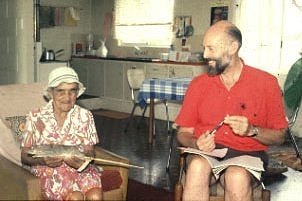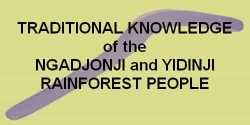Quest for Food
**Caution this page may contain images of persons now deceased**Quest for Food
Animal Foods
Eels
Plant Foods
Food Processing
During their thousands of years of living in the rainforests of North
Queensland, the Ngadjonji have acquired an intimate knowledge of the
plants and animals which shared their world.They discovered which fruits and seeds were good for eating and which ones needed processing to remove poisons before being used for food. They knew which parts of which plants at which time of year could be
used as medicine for particular ailments. They knew which vines yielded the best fibres for their intricately woven baskets and bags; which tree buttresses made the strongest swords and the lightest shields, and, in general, where to find all the materials they needed for the technology appropriate to their life in the rainforest.
With the arrival of Europeans and the resulting catastrophic disruption of the old Ngadjonji ways, there was a great danger that this traditional knowledge might have been lost forever. Luckily, there were a few Ngadjonji Elders who lived long enough to carry the knowledge through from before the breakdown to later times when it began to be valued for the wonderfully rich resource that it is.


Photo - Tony Irvine
Molly Raymont & Bob Dixon, Malanda 1988
Because of her excellent memory and great age - she lived to be over 100 - the late Ngadjonji Elder, Molly Raymont (Biographical Notes, Obituary), was a central figure in this custodianship of Ngadjonji Lore and Language. Bob Dixon, who spent years recording the languages of the Ngadjonji and other North Queensland aboriginal tribes, wrote of Molly:
"George Watson and Mollie and I went out into the bush with a botanist to identify native plants, each year from 1979 to 1982 - and old Mollie, ninety if she was a day, spindle-legged, walked us all off our feet, pointing with excitement at each new plant she found, giving its name in the everyday style and in Jalnguy ("Mother-in-law language"), explaining what it was used for, how it was cooked, and breaking off a piece to show us. She is truly indestructible." Bob Dixon "Searching for Aboriginal Languages"
The present day Ngadjonji Elders continue this generous willingness to share much of their rainforest lore with the wider community. These pages try to give a hint of this vast well of knowledge and understanding.
Between Cairns and Cardwell there was a diverse array of vegetation communities which provided a variety of resources for the Aborigines of this region prior to extensive clearing by European settlers. The Ngadjonji territory was dominated by one of the most structurally complex and floristically diverse types of rainforest classed as Complex Mesophyll Vine Forest under the Webb and Tracy classification system.
Tall deciduous or rain-green trees dominate the closed canopy and there are few low growing herbs or shrubs except where there have been disturbances. There are many vines and woody lianas which entwine around the trunks and climb up to the canopy. The lawyer canes, Calamus spp., with their inescapable prickles, are found frequently. They provided the Ngadjonji with the raw materials for janjuu (cane baskets) as well as being a source for food, both the raw berries and the roasted cane (shoots) being eaten.
There are many different types of plants in the rainforest. Botanists have described over nine hundred species of trees between Townsville and Cape Flattery. Single species seldom dominate even small areas so it was necessary for the tribe to walk considerable distances to find more than one or two individuals of a single species. An exception to this is the black bean, Castanospermum australe, called ganyjuu in Ngadjon. This was a major source of food for the Ngadjonji people in times past.

(Photograph Atkinson c.1890 -courtesy of Cairns Historical Society.)
Many of the unique elements of the rainforest culture, the lawyer cane basket ( janjuu ), the dome-shaped hut ( mija ), spears, shields and sword are displayed in this photograph.
Before European contact the Ngadjonji "enjoyed a lifestyle based on hunting, gathering and fishing to satisfy day to day needs. They gathered a wide variety of plants, using nuts, seeds, fruits, leaves and stems, roots and tubers, some of which were eaten raw and others cooked or processed in various ways. One of the distinctive cultural traits of the rainforest people was the regular and frequent use of poisonous plants as food sources. In other societies such foods were only occasionally utilised, but the rainforest people used sophisticated methods of detoxification for a number of different plant foods on a regular basis.
They also gathered the eggs of scrub-hens, scrub-turkeys and other birds in season. The scrub-hen lays a number of eggs and each one can be three times as heavy as the egg of a domestic hen. Since these megapods share their nesting mounds, many eggs may be found in each. Cayley notes a case where 48 scrub-turkey eggs were taken from one mound.
Their gathering activities also extended to invertebrates. At the appropriate time witchetty grubs were cut out from rotting fallen trees and honey gathered from native bees. While the women, accompanied by the children, usually gathered nuts and fruits, dug the yams and processed the toxic fruits, the men frequently pursued hunting activities. This included catching most of the animals available, often in specialised ways: wallabies were speared and trees were climbed to seek out possums, and to find carpet snakes sleeping in lofty ferns. Nooses made from lawyer cane were devised for catching goannas and nets made from fibre obtained from the inner bark of particular fig trees were used to trap scrub-turkeys.
Both women and men engaged in various methods of fishing depending on the season. Particular plants were known to stun fish if the leaves or other parts were crushed and placed in a dilly-bag in water which was not flowing. The stunned fish then floated to the surface and were gathered up. Long traps for eels were woven from split lawyer canes. These were set in the waterways with a fence of sticks each side of the mouth of the baskets. The eels had to enter and were promptly trapped
Pedley (1992) p5
A majority of rain-forest tree species of North-east Queensland fruit towards the end of the dry season and early in the wet season (Nov.-Jan.) They include most of the species that provide the edible nuts on which the Ngadjon to a large extent depended. Seasonal fruiting peaks also correlate with peaks in breeding activities of fruit eating species such as cassowaries, musky rat kangaroos, white tailed rat ( durrgim ), scrub turkeys, jungle fowl, insect populations and insectivorous birds. The main wet season from January to March is a lean period for animals and human foragers - whereas the late dry/early wet season is the time when plant and animal foods are most abundant. The Ngadjonji had detailed knowledge of when particular foods were ready to eat and where in their territory to find them. Tribal movement and ceremonial activities were of necessity keyed into the seasonal cycle, the unity between the people and the land provided the basis for all aspects of life.

